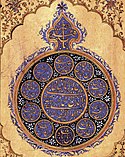| Alamgir I | |||||||||||||||||||||||||||||||||||||||||||||||||||||||||||||||||||||||
|---|---|---|---|---|---|---|---|---|---|---|---|---|---|---|---|---|---|---|---|---|---|---|---|---|---|---|---|---|---|---|---|---|---|---|---|---|---|---|---|---|---|---|---|---|---|---|---|---|---|---|---|---|---|---|---|---|---|---|---|---|---|---|---|---|---|---|---|---|---|---|---|
| Al-Mukarram[a] Al-Sultan al-Azam[1] Amir al-Mu'minin[b] Shahenshah-e-Sultanat Al-Hindiyyah (Emperor of the Sultanate of India)[1] | |||||||||||||||||||||||||||||||||||||||||||||||||||||||||||||||||||||||
 Portrait by Bichitr, c. 1660 | |||||||||||||||||||||||||||||||||||||||||||||||||||||||||||||||||||||||
| Emperor of Hindustan | |||||||||||||||||||||||||||||||||||||||||||||||||||||||||||||||||||||||
| Reign | 31 July 1658 – 3 March 1707 | ||||||||||||||||||||||||||||||||||||||||||||||||||||||||||||||||||||||
| Coronation | 31 July 1658[c] | ||||||||||||||||||||||||||||||||||||||||||||||||||||||||||||||||||||||
| Predecessor | Shah Jahan | ||||||||||||||||||||||||||||||||||||||||||||||||||||||||||||||||||||||
| Successor | Azam Shah | ||||||||||||||||||||||||||||||||||||||||||||||||||||||||||||||||||||||
| Grand Viziers | See list
| ||||||||||||||||||||||||||||||||||||||||||||||||||||||||||||||||||||||
| |||||||||||||||||||||||||||||||||||||||||||||||||||||||||||||||||||||||
| Born | Muhi al-Din Muhammad 3 November 1618[2] Dahod, Gujarat Subah, Mughal Empire | ||||||||||||||||||||||||||||||||||||||||||||||||||||||||||||||||||||||
| Died | 3 March 1707 (aged 88) Qila-e-Ark, Ahmednagar, Mughal Empire | ||||||||||||||||||||||||||||||||||||||||||||||||||||||||||||||||||||||
| Burial | |||||||||||||||||||||||||||||||||||||||||||||||||||||||||||||||||||||||
| Spouse |
| ||||||||||||||||||||||||||||||||||||||||||||||||||||||||||||||||||||||
| Issue Detail | |||||||||||||||||||||||||||||||||||||||||||||||||||||||||||||||||||||||
| House | House of Babur | ||||||||||||||||||||||||||||||||||||||||||||||||||||||||||||||||||||||
| Dynasty | Timurid | ||||||||||||||||||||||||||||||||||||||||||||||||||||||||||||||||||||||
| Father | Shah Jahan | ||||||||||||||||||||||||||||||||||||||||||||||||||||||||||||||||||||||
| Mother | Mumtaz Mahal | ||||||||||||||||||||||||||||||||||||||||||||||||||||||||||||||||||||||
| Religion | Sunni Islam[e] | ||||||||||||||||||||||||||||||||||||||||||||||||||||||||||||||||||||||
| Imperial Seal |  | ||||||||||||||||||||||||||||||||||||||||||||||||||||||||||||||||||||||
| Military career | |||||||||||||||||||||||||||||||||||||||||||||||||||||||||||||||||||||||
| Allegiance | |||||||||||||||||||||||||||||||||||||||||||||||||||||||||||||||||||||||
| Service | |||||||||||||||||||||||||||||||||||||||||||||||||||||||||||||||||||||||
| Commands | |||||||||||||||||||||||||||||||||||||||||||||||||||||||||||||||||||||||
| Battles / wars | |||||||||||||||||||||||||||||||||||||||||||||||||||||||||||||||||||||||
Muhi al-Din Muhammad (3 November 1618 – 3 March 1707), commonly known by the title Aurangzeb,[g] and also by his regnal name Alamgir I,[h][i] was the sixth Mughal emperor, reigning from 1658 until his death in 1707. Under his emperorship, Mughal Empire reached its greatest extent with territory spanning nearly the entirety of the Indian subcontinent.[6][7][8][9]
Aurangzeb and the Mughals belonged to a branch of the Timurid dynasty. He held administrative and military posts under his father Shah Jahan (r. 1628–1658) and gained recognition as an accomplished military commander. Aurangzeb served as the viceroy of the Deccan in 1636–1637 and the governor of Gujarat in 1645–1647. He jointly administered the provinces of Multan and Sindh in 1648–1652 and continued expeditions into the neighboring Safavid territories. In September 1657, Shah Jahan nominated his eldest and liberalist son Dara Shikoh as his successor, a move repudiated by Aurangzeb, who proclaimed himself emperor in February 1658. In April 1658, Aurangzeb defeated the allied army of Shikoh and the Kingdom of Marwar at the Battle of Dharmat. Aurangzeb's decisive victory at the Battle of Samugarh in May 1658 cemented his sovereignty and his suzerainty was acknowledged throughout the Empire. After Shah Jahan recovered from illness in July 1658, Aurangzeb declared him incompetent to rule and imprisoned his father in the Agra Fort.
Aurangzeb's reign is characterized by a period of rapid military expansion, with several dynasties and states being overthrown by the Mughals. The Mughals also surpassed Qing China as the world's largest economy and biggest manufacturing power. The Mughal military gradually improved and became one of the strongest armies in the world. A staunch Muslim, Aurangzeb is credited with the construction of numerous mosques and patronizing works of Arabic calligraphy. He successfully imposed the Fatawa-i Alamgiri as the principal regulating body of the empire and prohibited religiously forbidden activities in Islam. Although Aurangzeb suppressed several local revolts, he maintained cordial relations with foreign governments.
Aurangzeb was the longest reigning Mughal Emperor. His empire was also one of the largest in Indian history. However, his emperorship has a complicated legacy.[10] His critics, citing his actions against the non-Muslims and his conservative view of Islam, argue that he abandoned the legacy of pluralism and tolerance of the earlier Mughal emperors. Others, however, reject these assertions, arguing that he opposed bigotry against Hindus, Sikhs and Shia Muslims and that he employed significantly more Hindus in his imperial bureaucracy than his predecessors.
Cite error: There are <ref group=lower-alpha> tags or {{efn}} templates on this page, but the references will not show without a {{reflist|group=lower-alpha}} template or {{notelist}} template (see the help page).
- ^ a b "Tomb of Aurangzeb" (PDF). ASI Aurangabad. Archived from the original (PDF) on 23 September 2015. Retrieved 21 March 2015.
- ^ "Aurangzeb". Wikidata. 9 October 2017. Retrieved 10 July 2024.
- ^ Khomdan Singh Lisam (2011). Encyclopaedia Of Manipur (3 Vol.). Gyan Publishing House. p. 706. ISBN 9788178358642. Retrieved 20 March 2024.
... Aurangzeb Bahadur Alamgir I ( Conqueror of the Universe ) , more commonly known as Aurangzeb , the 6th Mughal Emperor ruled from 1658 to
- ^ Gul Rahim Khan (2021). "Silver Coins Hoard of the Late Mughals from Kohat". Ancient Pakistan. 18. Department of Archaeology, University of Peshawar: 16. ISSN 2708-4590.
In gold there is no more type. In silver some other types like Abu al Muzaffar Muhiuddin/ Muhammad (and date) / Bahadur Alamgir/ Aurangzeb/ Badshah Ghazi or ...
- ^ Proceedings of the Royal Irish Academy Volume 3. Harvard University; Royal Irish Academy. 1893. p. 398. Retrieved 20 March 2024.
The Emperor's name and title were proclaimed in the pulpit as Abu al-Muzaffar Bahadur ' Alamgir Badshah i Ghazi
- ^ Chapra, Muhammad Umer (2014). Morality and Justice in Islamic Economics and Finance. Edward Elgar Publishing. pp. 62–63. ISBN 978-1-78347-572-8.
Aurangzeb (1658–1707). Aurangzeb's rule, spanning a period of 49 years
- ^ Bayly, C.A. (1990). Indian society and the making of the British Empire (1st pbk. ed.). Cambridge [England]: Cambridge University Press. p. 7. ISBN 978-0-521-38650-0.
- ^ Turchin, Peter; Adams, Jonathan M.; Hall, Thomas D (December 2006). "East-West Orientation of Historical Empires". Journal of World-Systems Research. 12 (2): 223. ISSN 1076-156X. Retrieved 12 September 2016.
- ^ József Böröcz (2009). The European Union and Global Social Change. Routledge. p. 21. ISBN 978-1-135-25580-0. Retrieved 26 June 2017.
- ^ Ali, A.; Thiam, I.D.; Talib, Y.A. (2016). The Different aspects of Islamic culture: Islam in the World today; Retrospective of the evolution of Islam and the Muslim world. UNESCO Publishing. p. 51. ISBN 978-92-3-100132-1.